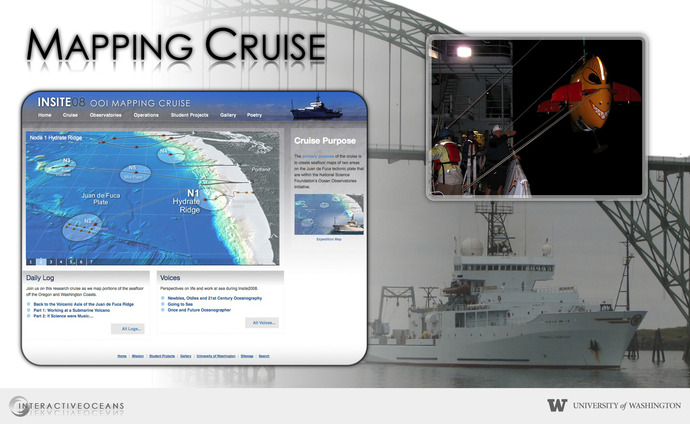The InSite08 cruise took place on the University of Washington’s Research Vessel (R/V) Thomas G. Thompson, 22 July to 5 August 2008, Seattle to Seattle, with a mid-cruise port call in Newport, Oregon. The primary purpose of the cruise was to map the seafloor at three study sites that will be located on the Regional Scale Nodes cable: Hydrate Ridge, the Endurance Array 500 meter site, and Axial Seamount.
Significant accomplishments were the following:
- High-quality overview bathymetric maps of sites at ~50-meter resolution obtained using the Thompson’s EM 300 transducer mounted on the hull of the ship.
- High-resolution bathymetric maps at ~1 meter resolution of these complex sites for deployment of Regional Scale Nodes infrastructure. The maps were obtained using the Autonomous Underwater Vehicle (AUV) Sentry on its first-ever formal science expedition.
- Collection of underwater digital photographs using TowCam to ground truth the EM300 and Sentry bathymetric data. TowCam is a tethered photographic system that is towed behind the vessel. On this cruise, the system was also configured to collect conductivity, temperature, and depth (CTD) data and Eh data. The Eh data are an indication of how chemically reactive a fluid might be, information that is particularly relevant near hydrothermal vent fields.
- First at-sea use of the Collaborative Ocean Visualization Environment (COVE) tool. On this cruise, COVE was used successfully and extensively for the planning and rapid layout of tracklines for the AUV and EM300 surveys, for optimal planning of camera deployments, and for rapid visualization of bathymetric data within hours of acquisition.
- Student education and engagement. Five undergraduates and one graduate student from the University of Washington and two post-undergraduate students from the College of Charleston participated in all aspects of cruise planning and activities. Four of the undergrads worked on cruise-specific research projects.






